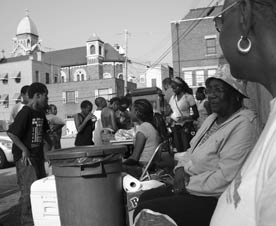TIAA-CREF also makes what could be considered community investments, or social venture-capital investments (more speculative up-front investments with a double bottom line), through its General Account. “The General Account investments, unlike the Social Choice Account, are private, and not traded daily,” which makes it easier to incorporate both real estate and unorthodox investments, explains Cherie Santos-Wuest, a director of the social and community-investment department.
Beyond conventional real-estate investments in urban office and apartment buildings, the Corporate Social Real Estate Program — financed from the General Account, not the Social Choice Account — increasingly focuses on workforce-housing development, aimed at creating housing for moderate-income workers, especially in areas where the gap between housing costs and median income has risen rapidly.
“Often there’s more than the double bottom line from these investments,” Santos-Wuest says, “because many of the new developments will be ‘green’ and built by minority developers.”
The Corporate Social Real Estate Program also focuses on reviving or creating retail in minority and low-income communities abandoned by mainstream retailers, encouraging in-fill development of housing and retail in cities and older suburbs, and supporting transit-oriented development.
The new investment in community banking, financed from the General Account, is already paying off. “Shorebank really specializes in investing in underinvested communities, and we have more loan demand than our ability to finance locally,” says Shorebank executive vice president Jean Pogge. “So when TIAA-CREF put in $22 million, it was enormously helpful. It was translated right away into lending because our loan growth is that strong.”
Many of the working-class, principally African-American and Latino homeowners from South and West Side Chicago neighborhoods served by Shorebank are now turning to the bank for “rescue mortgages.” Subprime borrowers with adjustable interest rates that are suddenly shooting upward can turn to Shorebank, which works closely with them to get fixed-rate mortgages and avoid foreclosure.
The new TIAA-CREF initiatives — including community investment in the Social Choice Account, microfinancing, Corporate Social Real Estate, and community banking — excite people like Timothy Smith, president of the Social Investment Forum, an organization of financial advisers, mutual funds, foundations, and others promoting socially responsible investing. “I think TIAA-CREF has not just moved forward for itself but has become a thought leader in taking environmental, social, and governance goals for investment into account,” he says. “I don’t mean they’re at the front of the pack, but their policy statement on governance, especially since it comes from a fund of $420 billion, is a powerful statement that these issues can’t be ignored by the investor community.”
Smith gives Wollman’s campaigns, as well as broader changes in society, credit for the change in TIAA-CREF policies. “I’m sure that the TIAA-CREF campaign [that Wollman led] would like to say it’s a result of their initiative, and that’s not unimportant,” he says. “It’s been a sustained voice from members. But another factor that’s probably even stronger is that [TIAA-CREF officials] are legally fiduciaries. They’re responsible for taking care of that money.” And investing in companies like Enron, or many socially irresponsible companies, can be costly.
John Taylor, president of the National Community Reinvestment Coalition (NCRC), a coalition of 600 nonprofit groups that began supporting Wollman’s campaign in 2000, is a little less impressed with TIAA-CREF’s own initiative and gives more credit to the campaign. “I’m pleased that [TIAA-CREF officials] have responded somewhat, but given their capacity, they could do so much more,” Taylor says. “It’s still a trickle what they’re contributing to socially responsible investments. They’re laggards, not leaders, most definitely.”
“I do think the [protest] groups have had an impact, but it’s David and Goliath,” Taylor says. “I think it’s been almost like water dripping. If you wait long enough, it drills a hole through the rock. I’m in awe [of] Neil and others who are part of the coalition, who continue to hammer away against all odds [at TIAA-CREF] and are really having an impact.”
Jeff Ballinger, organizer of Press for Change, a Nike critic that is part of Make TIAA-CREF Ethical, thinks that the growing involvement of teacher organizations may strengthen the ad-hoc coalition. The TIAA-CREF campaigns have “limped along year to year mainly through efforts of Neil to keep people active,” Ballinger says. “But, he has won some struggles in the corner he has focused on, which is the lending.” Ballinger argues that organizational muscle will be needed in the fight to use TIAA-CREF investments as a way to change the behavior of big corporations, like Nike.
Over the past decade, socially responsible investment overall has surged — from $639 billion in 1995 to $2.29 trillion in 2005. Shareholder challenges, especially on governance issues like executive pay, are growing more effective. Maybe TIAA-CREF would have caught the wave at some point on its own, but there is no denying that the shoe-string campaign of Neil Wollman and his allies played a major role in making the giant investment company eventually do what its investors wanted — to do good while making money. Wollman thinks TIAA-CREF can do even better, and he’s not stopping until they do.





Comments